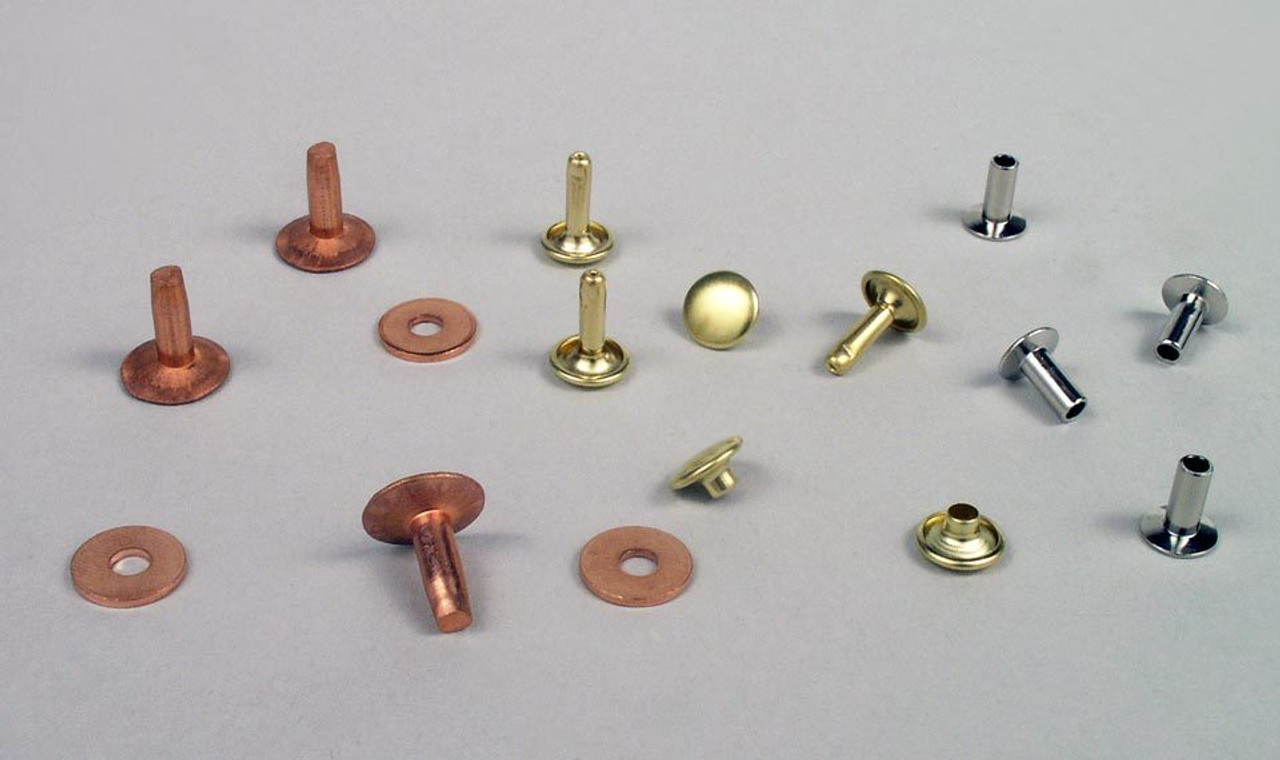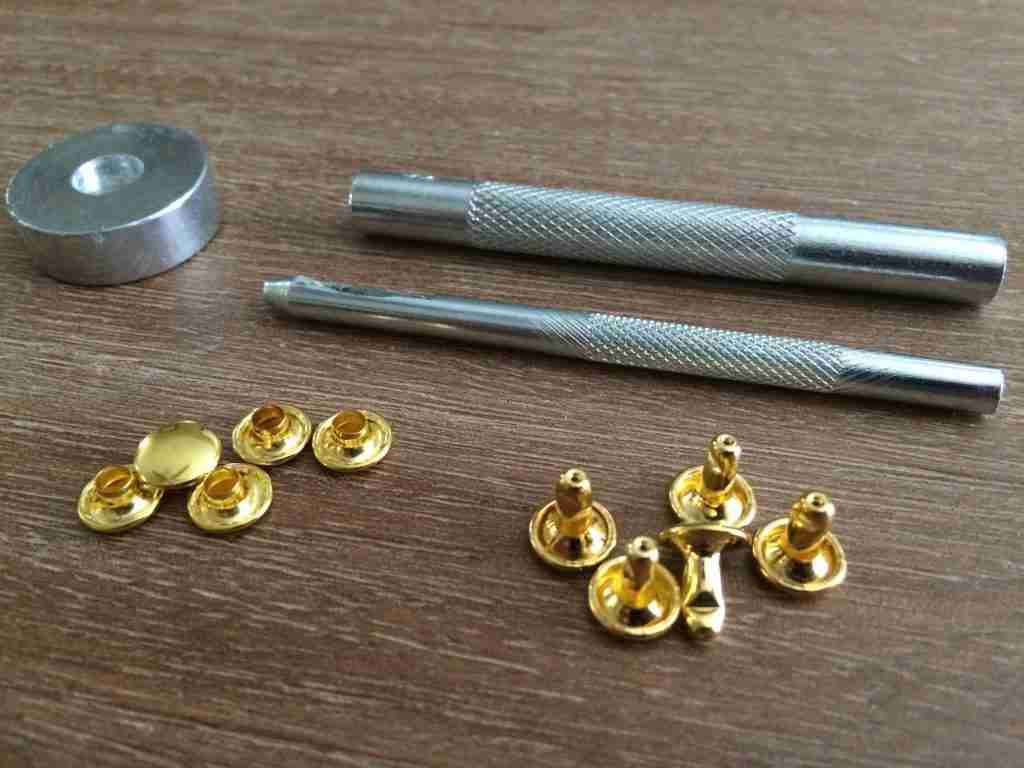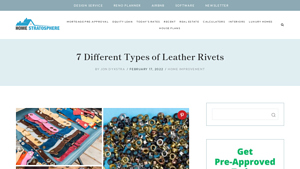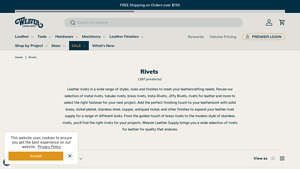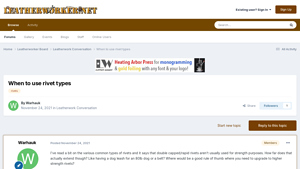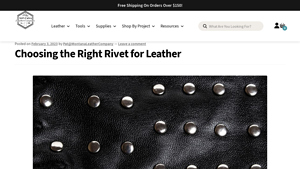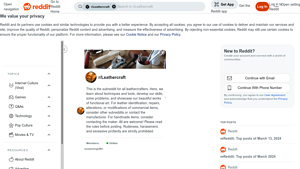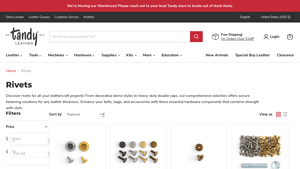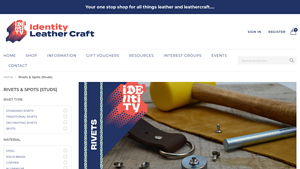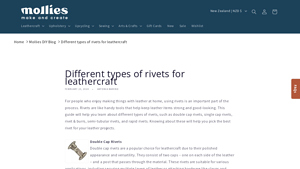Types Of Rivets For Leather Guide: Type, Cost, Top List…
Introduction: Navigating the Global Market for types of rivets for leather
In the competitive landscape of leathercraft, sourcing the right types of rivets for leather can present a significant challenge for international B2B buyers. Whether you’re based in Nigeria, Vietnam, or elsewhere, understanding the nuances of rivet selection is essential for ensuring both the durability and aesthetic appeal of your leather products. This guide delves into a comprehensive array of rivet types, including rapid, double cap, tubular, and copper rivets, each tailored for specific applications ranging from fashion accessories to heavy-duty industrial uses.
Navigating the global market for leather rivets requires more than just product knowledge; it demands insights into supplier vetting, pricing strategies, and the unique needs of diverse regions. Buyers will find actionable advice on how to assess quality, select the most suitable rivet types for their projects, and make informed purchasing decisions that align with their business goals.
By equipping yourself with this detailed guide, you can streamline your procurement process and enhance your competitive edge in the leather goods market. Whether your focus is on quality, cost-effectiveness, or supplier reliability, this resource is designed to empower you with the knowledge needed to thrive in a dynamic international marketplace.
Understanding types of rivets for leather Types and Variations
| Type Name | Key Distinguishing Features | Primary B2B Applications | Brief Pros & Cons for Buyers |
|---|---|---|---|
| Rapid Rivets | Single cap, versatile, easy to install | Fashion accessories, belts, bags | Pros: Easy installation, cost-effective. Cons: Less durable for heavy-duty applications. |
| Double Cap Rivets | Finished caps on both ends, heavy-duty | Dog collars, industrial leather goods | Pros: Stronger hold, more aesthetic. Cons: Higher cost, may require specialized tools. |
| Tubular Rivets | Thick posts, ideal for industrial use | Heavy-duty applications, tool cases | Pros: Very strong, suitable for thick materials. Cons: Requires specific setting tools, more complex installation. |
| Copper Rivets | Flexible sizing, corrosion-resistant | Custom leatherwork, high-end products | Pros: Durable, aesthetic appeal. Cons: More expensive than other types, can require custom sizing. |
| Split Rivets | Two or three pin tails for added grip | Upholstery, decorative leather projects | Pros: Secure fastening, decorative options available. Cons: Installation can be more time-consuming. |
What Are the Characteristics of Rapid Rivets for Leather?
Rapid rivets, also known as single cap rivets, are distinguished by their simple design and ease of installation. They consist of a post and a cap, making them suitable for various leather applications, including fashion accessories, belts, and bags. For B2B buyers, rapid rivets present a cost-effective solution for projects that do not require heavy-duty fastening. Their versatility, however, comes at the expense of durability, making them less ideal for high-stress environments.
Why Choose Double Cap Rivets for Heavy-Duty Applications?
Double cap rivets feature caps on both ends, providing enhanced strength and a more polished appearance. They are commonly used in products like dog collars and industrial leather goods, where durability and aesthetics are paramount. B2B buyers should consider double cap rivets when seeking a robust fastening solution that can withstand wear and tear. Although they are more expensive than rapid rivets and may require specialized setting tools, their superior strength justifies the investment for many applications.
How Do Tubular Rivets Enhance Industrial Applications?
Tubular rivets are characterized by their thicker posts, making them ideal for industrial applications requiring high strength. They are often used in heavy-duty products such as tool cases and industrial belts. B2B buyers should note that while tubular rivets offer exceptional strength, they necessitate specific setting tools, which can complicate installation. However, their ability to secure thick materials effectively makes them a preferred choice in demanding environments.
What Are the Benefits of Using Copper Rivets?
Copper rivets are known for their corrosion resistance and aesthetic appeal, making them suitable for custom leatherwork and high-end products. Their flexibility in sizing allows for a tailored fit, which is particularly advantageous for specialized projects. B2B buyers should weigh the benefits of durability and visual appeal against the higher cost associated with copper rivets. While they provide a premium option, the investment may be worthwhile for products aimed at discerning customers.
When to Use Split Rivets in Leather Projects?
Split rivets, featuring two or three pin tails, are designed to offer a secure fastening while also providing decorative options. They are commonly used in upholstery and decorative leather projects. B2B buyers should consider split rivets when aesthetics and secure fastening are essential. However, the installation process can be more time-consuming compared to other rivet types, which may impact production timelines. Understanding the balance between decorative appeal and installation efficiency is key for buyers in this category.
Key Industrial Applications of types of rivets for leather
| Industry/Sector | Specific Application of types of rivets for leather | Value/Benefit for the Business | Key Sourcing Considerations for this Application |
|---|---|---|---|
| Fashion & Apparel | Riveting leather belts and accessories | Enhances durability and aesthetic appeal of products | Sourcing rivets that align with design specifications and durability requirements. |
| Automotive | Upholstery and interior leather components | Provides strong, secure fastening for long-lasting interiors | Ensuring rivet materials resist rust and wear under varying conditions. |
| Furniture Manufacturing | Leather furniture assembly and repair | Improves structural integrity while allowing design flexibility | Selecting rivets that can support heavy loads and match furniture finishes. |
| Pet Products | Manufacturing dog collars and leashes | Offers secure attachment points for safety and style | Choosing rivets that withstand outdoor conditions and are easy to install. |
| Industrial Equipment | Tool cases and protective leather gear | Ensures durability and functionality in demanding environments | Sourcing heavy-duty rivets suitable for high-stress applications and custom sizes. |
How Are Rivets Used in the Fashion & Apparel Industry?
In the fashion and apparel sector, rivets are commonly used to join leather in belts, handbags, and jackets. The use of rapid and double cap rivets not only enhances the durability of these items but also adds a decorative element that appeals to consumers. International buyers should consider the aesthetic and functional aspects of rivets, ensuring they select options that align with current fashion trends while providing strength. Sourcing rivets that are resistant to corrosion is crucial, especially in humid climates found in regions like Africa and South America.
What Role Do Rivets Play in the Automotive Industry?
In the automotive sector, rivets are essential for fastening leather upholstery and interior components. Their ability to provide a strong, permanent bond makes them ideal for applications where safety and longevity are paramount. Buyers in this industry must ensure that the rivets chosen can withstand exposure to heat, moisture, and wear over time. Sourcing options that are resistant to rust and designed for high-stress environments can significantly enhance the quality of automotive interiors.
Why Are Rivets Important for Furniture Manufacturing?
Furniture manufacturers utilize rivets to assemble and repair leather furniture, providing both strength and flexibility in design. The combination of style and structural integrity is vital for consumer satisfaction and product longevity. Buyers should focus on rivets that can support heavy loads while maintaining a seamless finish. Additionally, sourcing rivets that match the color and texture of the leather can enhance the overall aesthetic of the furniture, making it more appealing to end consumers.
How Are Rivets Used in Pet Products?
In the production of pet products like collars and leashes, rivets serve a critical function by securely attaching components to ensure safety and durability. The choice of rivet material is particularly important, as products must endure outdoor conditions and rough handling. International buyers should look for rivets that are easy to install and provide a secure fit without compromising the design. Sourcing options that are weather-resistant and durable will help ensure the safety and satisfaction of pet owners.
What Are the Applications of Rivets in Industrial Equipment?
Rivets are frequently used in the assembly of tool cases and protective leather gear within industrial settings. Their strength and reliability are crucial for ensuring that equipment remains safe and functional in demanding environments. Buyers should prioritize heavy-duty rivets that can withstand high-stress applications and consider custom sizes for specific needs. Additionally, sourcing rivets that offer resistance to wear and environmental factors will help maintain the integrity of industrial equipment over time.
3 Common User Pain Points for ‘types of rivets for leather’ & Their Solutions
Scenario 1: Misalignment of Rivet Types with Project Needs
The Problem: B2B buyers often face the challenge of selecting the appropriate rivet type for specific leather projects. For example, a buyer may choose rapid rivets for a heavy-duty leather item, only to find that the rivets fail under stress, leading to costly returns and reputational damage. This misalignment stems from a lack of understanding about the different rivet types available—such as single cap, double cap, tubular, and copper—and their specific applications. Each type has unique strength, durability, and aesthetic characteristics, making it crucial for buyers to match the rivet type with the intended use.
The Solution: To mitigate this issue, buyers should invest time in a thorough assessment of their project requirements before sourcing rivets. This includes understanding the leather thickness, the anticipated stress on the rivets, and whether the rivets will serve a functional or decorative purpose. A well-defined specification sheet can aid in communicating needs to suppliers. Additionally, buyers should consider utilizing samples from manufacturers to test rivet performance under actual conditions. Collaborating with experienced leather craftsmen or seeking advice from technical experts can also provide invaluable insights, ensuring the chosen rivet type aligns perfectly with project needs.
Scenario 2: Inefficient Rivet Installation Techniques
The Problem: Another common pain point for B2B buyers is the improper installation of rivets, which can lead to structural failure in leather goods. Many businesses rely on manual installation methods that can result in uneven pressure and misalignment, especially when dealing with different rivet types that require specific tools and techniques. This can cause the rivets to loosen over time, leading to returns and increased production costs.
The Solution: To address this problem, companies should standardize their rivet installation processes by investing in the right tools and training. For instance, using a rivet setter specifically designed for each rivet type can ensure consistent pressure is applied during installation. Additionally, incorporating a training module for employees on the correct installation techniques—such as using the appropriate anvil and hammer for each rivet type—can significantly reduce errors. Periodic quality checks and feedback loops can further enhance installation practices, ensuring long-term durability of the leather products.
Scenario 3: Inconsistent Quality of Rivets from Suppliers
The Problem: Many B2B buyers experience difficulties with inconsistent rivet quality, which can vary significantly between suppliers. This inconsistency can lead to issues such as rusting, breaking, or poor aesthetic appeal, which ultimately affects the quality of the final product. Buyers from regions with diverse sourcing options, like Africa and South America, may find it challenging to maintain a reliable supply chain for high-quality rivets, leading to project delays and customer dissatisfaction.
The Solution: To combat this pain point, B2B buyers should establish long-term relationships with reputable suppliers who can provide consistent quality. Conducting thorough supplier audits, including reviews of their manufacturing processes and quality control measures, can help ensure that the rivets meet industry standards. Additionally, buyers should implement a quality assurance process upon receiving shipments, including testing samples from each batch before full-scale use. Collaborating with other businesses in the leather industry to share supplier evaluations can also foster a community of informed buyers, leading to better sourcing decisions and higher quality products.
Strategic Material Selection Guide for types of rivets for leather
What Are the Key Properties of Different Materials Used for Leather Rivets?
When selecting rivets for leather applications, the choice of material is critical to ensure optimal performance and durability. Here, we analyze four common materials used in leather rivets: brass, copper, steel, and aluminum.
How Does Brass Affect Rivet Performance in Leather Applications?
Brass rivets are known for their excellent corrosion resistance and aesthetic appeal. They perform well under a range of temperatures and pressures, making them suitable for both indoor and outdoor applications. The key advantage of brass is its resistance to tarnishing and rust, which is crucial for products exposed to moisture, such as bags and outdoor gear.
However, brass rivets can be more expensive than other options, which may impact budget-sensitive projects. Additionally, while they are durable, they can be prone to bending under excessive force, making them less suitable for high-stress applications. For international buyers, it is important to ensure compliance with standards such as ASTM B16 for brass alloys, particularly in regions with strict quality regulations.
What Are the Benefits and Limitations of Copper Rivets?
Copper rivets offer a unique combination of strength and flexibility, making them ideal for heavy-duty leather applications. They are particularly well-suited for items that require a robust fastening solution, such as tool belts and heavy bags. Copper’s natural resistance to corrosion is a significant advantage, especially in humid environments.
On the downside, copper rivets can oxidize over time, leading to a patina that may not be desirable for all products. They are also generally more expensive than steel rivets. For buyers in Africa and South America, where humidity is a concern, the choice of copper rivets can enhance product longevity, but they should also consider the aesthetic implications of oxidation.
How Do Steel Rivets Compare in Terms of Durability and Cost?
Steel rivets are renowned for their strength and durability, making them suitable for industrial applications. They can withstand high pressure and are less likely to bend or break compared to softer metals. This makes steel rivets a cost-effective choice for manufacturers producing heavy-duty leather goods.
However, steel is prone to rusting if not properly treated, which can be a significant drawback for products exposed to moisture. Buyers should seek galvanized or stainless steel options to mitigate this issue. Compliance with standards such as DIN 7337 can be important for international buyers, especially in Europe, where quality assurance is prioritized.
What Advantages Do Aluminum Rivets Offer for Lightweight Applications?
Aluminum rivets are lightweight and resistant to corrosion, making them an excellent choice for applications where weight is a critical factor, such as in fashion accessories or lightweight bags. They are also less expensive than brass and copper, which can help reduce overall production costs.
The main limitation of aluminum rivets is their lower strength compared to steel or brass, which may not make them suitable for high-stress applications. Additionally, they can be more susceptible to deformation under heavy loads. International buyers from regions like the Middle East should consider the specific application requirements and ensure that aluminum rivets meet relevant standards, such as JIS H 4000.
Summary Table of Rivet Materials for Leather Applications
| Material | Typical Use Case for types of rivets for leather | Key Advantage | Key Disadvantage/Limitation | Relative Cost (Low/Med/High) |
|---|---|---|---|---|
| Brass | Outdoor gear, bags | Excellent corrosion resistance | More expensive, can bend under stress | Medium |
| Copper | Tool belts, heavy bags | Strong and flexible | Oxidizes over time | High |
| Steel | Industrial applications, heavy-duty items | High strength and durability | Prone to rust without treatment | Low |
| Aluminum | Fashion accessories, lightweight bags | Lightweight and corrosion-resistant | Lower strength, can deform easily | Medium |
This strategic material selection guide provides valuable insights for B2B buyers in diverse markets, enabling them to make informed decisions based on application requirements and regional considerations.
In-depth Look: Manufacturing Processes and Quality Assurance for types of rivets for leather
What Are the Main Stages in the Manufacturing Process of Leather Rivets?
The manufacturing of leather rivets involves several critical stages that ensure the final product meets the required specifications for durability, appearance, and functionality. Understanding these stages can aid B2B buyers in selecting the right suppliers for their needs.
Material Preparation: What Raw Materials Are Used for Leather Rivets?
The first step in the rivet manufacturing process is material preparation. Most leather rivets are made from metals like brass, copper, or steel. These materials are chosen for their strength, corrosion resistance, and aesthetic qualities. For example, solid brass and copper rivets are commonly used for their rust-resistant properties, making them ideal for outdoor applications.
The raw materials undergo initial quality checks to verify their composition and mechanical properties. This step ensures that the materials meet the required industry standards before proceeding to the forming stage.
How Are Leather Rivets Formed During Manufacturing?
Once the materials are prepared, the next stage is forming. This involves shaping the raw materials into the various components of the rivets, which typically include the post and the cap.
-
Stamping: This technique is commonly used to produce the caps and posts. High-precision stamping machines apply significant pressure to cut and shape the metal sheets into the desired forms.
-
Turning: For rivets requiring specific dimensions, turning processes may be utilized. This involves rotating the material against a cutting tool to achieve precise measurements.
-
Extrusion: In the case of tubular rivets, the metal is forced through a die to create a hollow tube that forms the post. This technique is essential for ensuring the strength and durability of the rivet.
What Happens During the Assembly Stage of Rivet Manufacturing?
After the individual components are formed, the assembly stage begins. This process involves joining the cap and post together, often using automated machines for efficiency.
-
Insertion: The post is inserted through a pre-punched hole in the leather.
-
Crimping: The assembly is completed by crimping the post to secure the cap in place. This can be done using a variety of tools, including hand-held setters or hydraulic presses, depending on the rivet type and intended application.
-
Quality Inspection: Throughout the assembly process, operators conduct visual inspections to ensure that each rivet is correctly assembled and free from defects.
How is the Finishing Process of Leather Rivets Carried Out?
The finishing stage involves several treatments that enhance the rivet’s appearance and performance. This includes:
-
Plating: Rivets may undergo electroplating to improve corrosion resistance and provide an aesthetic finish. Common plating materials include nickel, chrome, and gold.
-
Polishing: To achieve a smooth surface, rivets are polished, which also helps to remove any sharp edges.
-
Coating: In some cases, a protective coating may be applied to enhance durability, particularly for rivets intended for outdoor use.
What Quality Control Measures Are Essential for Leather Rivet Manufacturing?
Quality control is a fundamental aspect of the manufacturing process, ensuring that the rivets meet international standards and customer expectations.
What Are the Key International Standards Relevant to Leather Rivet Quality Assurance?
B2B buyers should be aware of the international quality standards that govern the manufacturing of leather rivets. The most relevant standards include:
-
ISO 9001: This standard focuses on quality management systems and is applicable across various industries. Suppliers certified under ISO 9001 demonstrate a commitment to quality in their processes.
-
CE Marking: For products sold in the European Economic Area, CE marking signifies that the rivets meet EU safety, health, and environmental protection requirements.
-
API Standards: For rivets used in industrial applications, adherence to API (American Petroleum Institute) standards may be necessary, particularly for oil and gas applications.
What Are the QC Checkpoints Throughout the Manufacturing Process?
Quality control checkpoints are integrated at various stages of the manufacturing process:
-
Incoming Quality Control (IQC): This initial checkpoint involves testing raw materials for compliance with specified standards before they are used in production.
-
In-Process Quality Control (IPQC): During the forming and assembly stages, random samples are taken for testing. This may include dimensional checks, strength tests, and visual inspections to ensure consistency and quality.
-
Final Quality Control (FQC): Once the rivets are finished, a comprehensive inspection is conducted. This includes testing for functionality, durability, and aesthetic quality. Any defective products are rejected and analyzed for root causes.
How Can B2B Buyers Verify Supplier Quality Control Practices?
Verifying a supplier’s quality control practices is crucial for B2B buyers to ensure product reliability. Here are several methods:
-
Supplier Audits: Conducting on-site audits allows buyers to assess the supplier’s manufacturing processes and quality control measures directly. This can provide insight into their adherence to international standards.
-
Quality Reports: Requesting detailed quality reports can help buyers understand the supplier’s quality metrics, including defect rates and compliance with standards.
-
Third-Party Inspections: Engaging third-party inspection services can provide an unbiased evaluation of the supplier’s quality control processes and product reliability.
What QC Considerations Should International B2B Buyers Keep in Mind?
When sourcing leather rivets internationally, B2B buyers should consider the following nuances:
-
Regulatory Compliance: Different regions may have specific regulations regarding materials and manufacturing processes. Buyers should ensure that their suppliers comply with local and international regulations.
-
Cultural and Regional Differences: Understanding the cultural context and business practices in regions such as Africa, South America, the Middle East, and Europe can facilitate smoother negotiations and partnerships.
-
Communication: Establishing clear communication channels with suppliers is vital for addressing any quality concerns promptly and effectively.
By understanding the manufacturing processes and quality assurance measures for leather rivets, B2B buyers can make informed decisions, ensuring they source high-quality products that meet their specific needs.
Practical Sourcing Guide: A Step-by-Step Checklist for ‘types of rivets for leather’
To assist B2B buyers in sourcing rivets for leather, this guide outlines a practical checklist that ensures informed decision-making. Rivets play a crucial role in leatherwork, providing strength and aesthetic appeal to various products, from fashion accessories to industrial applications. Understanding the types and specifications of rivets is essential for successful procurement.
Step 1: Identify Your Project Requirements
Before sourcing rivets, clearly define the specific requirements of your leather project. Consider the type of leather you are using, the weight and thickness of the material, and the intended use of the final product. Different rivets offer varying strengths and aesthetic qualities, so understanding your project’s needs will guide your selection process.
Step 2: Research Different Types of Rivets
Familiarize yourself with the various types of rivets available in the market. Common types include:
– Rapid Rivets: Versatile and easy to use for lightweight applications.
– Double Cap Rivets: Provide a more durable solution with added aesthetic appeal.
– Tubular Rivets: Ideal for industrial applications due to their strength.
Understanding these options will help you select the right rivet type for your specific needs.
Step 3: Define Your Technical Specifications
Establish the technical specifications for the rivets you require. Key factors include:
– Material: Choose between brass, copper, or steel based on corrosion resistance and strength.
– Dimensions: Specify diameter and post length according to the thickness of the leather.
Clearly defining these specifications ensures that the rivets will perform as intended in your applications.
Step 4: Evaluate Potential Suppliers
Conduct thorough evaluations of potential suppliers to ensure reliability and quality. Request:
– Company Profiles: Assess their experience and expertise in leather rivet manufacturing.
– Product Samples: Examine the quality and performance of their rivets.
– References: Speak with other businesses that have sourced from them to gauge satisfaction.
This step is critical to establishing a trustworthy supply chain.
Step 5: Verify Certifications and Compliance
Ensure that your suppliers comply with relevant industry standards and certifications. This can include:
– ISO Certifications: Indicative of quality management practices.
– Safety Standards: Compliance with regulations specific to your region or industry.
Verifying these credentials minimizes risks associated with product quality and safety.
Step 6: Assess Pricing and Payment Terms
When considering suppliers, evaluate their pricing structures and payment terms. Look for:
– Bulk Discounts: Many suppliers offer reduced rates for larger orders.
– Payment Flexibility: Ensure that terms align with your budgetary constraints.
Comparing these factors across suppliers can lead to better overall cost management.
Step 7: Plan for Logistics and Delivery
Finally, consider the logistics involved in sourcing rivets. Assess:
– Shipping Options: Understand the delivery times and costs associated with various shipping methods.
– Inventory Management: Plan for storage and inventory replenishment to avoid production delays.
A well-organized logistics plan ensures a smooth procurement process and uninterrupted production flow.
By following this checklist, B2B buyers can make informed decisions when sourcing rivets for leather, ultimately enhancing the quality and efficiency of their leathercraft projects.
Comprehensive Cost and Pricing Analysis for types of rivets for leather Sourcing
What Are the Key Cost Components in Sourcing Leather Rivets?
When evaluating the cost structure for leather rivets, several components must be considered. The primary cost components include materials, labor, manufacturing overhead, tooling, quality control (QC), logistics, and margins.
-
Materials: The type of material used for rivets significantly impacts cost. Common materials include brass, copper, steel, and plastic. Brass and copper rivets generally command higher prices due to their durability and resistance to corrosion, making them ideal for applications exposed to moisture.
-
Labor: Labor costs can vary based on the complexity of the rivet design and the skill level required for production. Skilled labor is necessary for high-quality rivet setting, especially for decorative rivets that require precision.
-
Manufacturing Overhead: This encompasses costs related to utilities, rent, and equipment maintenance. Facilities that employ advanced machinery for rivet production may have higher overhead costs but can achieve economies of scale.
-
Tooling: The initial investment in tooling can be significant, particularly for custom rivets. The cost of dies and molds varies based on design complexity and material specifications.
-
Quality Control (QC): Implementing strict quality control measures is essential, especially for B2B buyers focused on reliability. This involves inspection processes that ensure rivets meet specified standards, which can add to the overall cost.
-
Logistics: Shipping and handling costs can be substantial, particularly for international shipments. Factors such as shipping distance, weight, and packaging requirements affect logistics costs.
-
Margin: Suppliers typically add a margin to cover their costs and profit. This margin can vary widely based on supplier pricing strategies and market demand.
How Do Price Influencers Impact Leather Rivet Costs?
Several factors influence the pricing of leather rivets, making it crucial for buyers to understand these dynamics:
-
Volume/MOQ: Minimum order quantities (MOQs) can significantly impact pricing. Larger orders often lead to discounts due to economies of scale, allowing suppliers to reduce costs.
-
Specifications/Customization: Custom designs or specific specifications can increase costs due to additional labor and tooling requirements. Buyers should be clear about their needs to avoid unexpected expenses.
-
Materials: The choice of materials not only affects the price but also the rivet’s performance. Buyers must balance the cost with the desired durability and application.
-
Quality/Certifications: Rivets that meet specific industry standards or certifications typically have higher price points. Buyers in sectors such as automotive or aerospace may require certified products, influencing their purchasing decisions.
-
Supplier Factors: The supplier’s reputation, location, and production capabilities can affect pricing. Established suppliers with advanced facilities may charge more but can deliver higher quality and reliability.
-
Incoterms: Understanding Incoterms is essential for international buyers, as they dictate responsibility for shipping costs and risks. This can significantly affect the total cost of acquisition.
What Are the Best Tips for B2B Buyers to Optimize Rivet Costs?
To ensure cost-efficiency when sourcing leather rivets, buyers should consider the following strategies:
-
Negotiate Pricing: Establishing long-term relationships with suppliers can provide leverage for better pricing. Don’t hesitate to negotiate based on volume and loyalty.
-
Assess Total Cost of Ownership (TCO): Evaluate the long-term costs associated with rivets, including maintenance, replacement, and potential failures. A lower upfront cost may not always lead to savings in the long run.
-
Understand Pricing Nuances: International buyers should be aware of currency fluctuations, tariffs, and import taxes that can impact final costs. It’s advisable to factor these elements into the total cost analysis.
-
Evaluate Multiple Suppliers: Comparing quotes from various suppliers can reveal significant price differences. Ensure that you are comparing similar specifications and quality standards.
-
Plan for Future Needs: If you anticipate increased demand, consider placing larger orders to lock in prices. This can be particularly beneficial in volatile markets.
Disclaimer on Pricing
Prices for leather rivets can vary widely based on the factors discussed above. Buyers are encouraged to conduct thorough market research and obtain multiple quotations to ensure they are making informed purchasing decisions.
Alternatives Analysis: Comparing types of rivets for leather With Other Solutions
Exploring Alternatives to Rivets for Leather Applications
In the realm of leather craftsmanship, rivets serve as a popular fastening solution due to their durability and ease of use. However, there are alternative methods and technologies that can achieve similar results, each with its own set of advantages and disadvantages. This analysis explores how traditional rivets compare to other fastening solutions, helping B2B buyers make informed decisions based on their specific needs.
Comparison Table
| Comparison Aspect | Types Of Rivets For Leather | Stitching | Adhesive Bonding |
|---|---|---|---|
| Performance | High durability and strength, suitable for heavy-duty applications. | Excellent for flexibility and aesthetics, but can weaken over time. | Strong initial bond, but can degrade with moisture and heat. |
| Cost | Moderate; costs vary based on rivet type and quantity. | Varies significantly based on thread type and labor costs. | Generally lower initial cost but may require reapplication. |
| Ease of Implementation | Requires specific tools (e.g., setters) and techniques for proper installation. | Simple for experienced craftsmen but time-consuming for complex patterns. | Quick application with minimal tools required. |
| Maintenance | Low; rivets are long-lasting and require little upkeep. | Moderate; stitching may require periodic checks and repairs. | Variable; adhesive may need replacement if degraded. |
| Best Use Case | Ideal for heavy-duty items like belts and tool cases. | Best for garments and decorative applications requiring flexibility. | Suitable for quick fixes and lightweight projects. |
What Are the Advantages and Disadvantages of Stitching as an Alternative to Rivets?
Stitching involves sewing two or more pieces of leather together, often using durable thread. This method offers significant flexibility, allowing for intricate designs that rivets cannot provide. However, stitching can weaken over time, especially when exposed to moisture. While it can be aesthetically pleasing, it requires skilled labor and can be time-consuming, impacting production timelines.
How Does Adhesive Bonding Compare to Riveting?
Adhesive bonding utilizes strong glues or adhesives to join leather pieces together. This method is advantageous for its simplicity and speed of application, requiring minimal tools. However, the longevity of adhesive bonds can be compromised by environmental factors like heat and moisture. While suitable for lightweight projects or quick repairs, adhesive bonding may not be ideal for heavy-duty applications where durability is paramount.
Making the Right Choice: How Should B2B Buyers Decide on the Best Fastening Solution?
When selecting a fastening method for leather goods, B2B buyers should consider the specific demands of their projects. If durability and strength are primary concerns, types of rivets may be the best option, particularly for items subjected to stress, such as belts or tool cases. Conversely, if aesthetics and flexibility are essential, stitching may be more suitable. For quick, lightweight applications, adhesive bonding could provide a cost-effective solution. Ultimately, understanding the unique requirements of each project will guide buyers to the most appropriate fastening method, ensuring quality and satisfaction in their leather products.
Essential Technical Properties and Trade Terminology for types of rivets for leather
What Are the Key Technical Properties of Leather Rivets That B2B Buyers Should Consider?
When sourcing rivets for leather applications, understanding the technical properties is crucial for ensuring product quality and suitability for specific projects. Here are some essential specifications to consider:
-
Material Grade
The material of the rivet significantly affects its durability and corrosion resistance. Common materials include brass, copper, and stainless steel. Brass and copper rivets are favored for their resistance to rust, making them ideal for outdoor products. In contrast, steel rivets may corrode when exposed to moisture, which can be a concern for items like leather bags or belts used in humid environments. For B2B buyers, selecting the right material grade ensures the longevity of the final product and minimizes warranty claims. -
Post Length
The length of the rivet post is critical for achieving a secure fit. Posts that are too long can lead to improper setting, while those that are too short may not provide sufficient grip. B2B buyers should match post lengths to the thickness of the leather being used, as this will directly affect the rivet’s holding strength and the overall aesthetic of the finished product. Properly sized posts contribute to the efficiency of the production process and reduce the likelihood of returns due to assembly issues. -
Diameter
The diameter of the rivet affects its strength and the size of the hole required in the leather. Rivets are typically available in various diameters, with larger diameters providing greater strength. However, they also require larger pre-punched holes, which may not be suitable for all leather thicknesses. Understanding the relationship between rivet diameter and leather thickness helps buyers avoid compatibility issues, ensuring a smoother manufacturing process. -
Head Shape and Size
The shape and size of the rivet head can impact both aesthetics and functionality. Rivets with larger heads distribute stress more evenly and provide a stronger hold, while decorative heads can enhance the visual appeal of leather products. B2B buyers should consider the intended use of the leather item—whether for industrial applications or fashion items—when selecting rivet head styles. This choice can influence customer satisfaction and brand perception. -
Tensile Strength
Tensile strength measures how much load a rivet can withstand before failing. Rivets with high tensile strength are essential for applications involving heavy-duty use, such as in industrial belts or heavy bags. B2B buyers should inquire about tensile strength ratings to ensure that the rivets meet the demands of their specific applications, which can prevent costly product failures.
What Are Some Common Trade Terms Used in the Leather Rivet Industry?
Familiarity with industry terminology can facilitate smoother transactions and negotiations. Here are some essential trade terms relevant to B2B buyers in the leather rivet market:
-
OEM (Original Equipment Manufacturer)
OEM refers to companies that manufacture products that are then sold under another company’s brand name. In the leather rivet industry, buyers may source rivets from OEMs for use in their own products, often seeking custom solutions that align with their brand requirements. -
MOQ (Minimum Order Quantity)
MOQ is the smallest quantity of a product that a supplier is willing to sell. Understanding MOQs is vital for B2B buyers as it affects inventory management and production costs. Buyers should negotiate MOQs that align with their demand forecasts to optimize cash flow. -
RFQ (Request for Quotation)
An RFQ is a formal document sent to suppliers requesting price quotes for specific products. When sourcing rivets, buyers typically issue RFQs to gather competitive pricing and assess supplier capabilities. A well-structured RFQ can lead to better pricing and favorable contract terms. -
Incoterms (International Commercial Terms)
Incoterms are standardized trade terms that define the responsibilities of buyers and sellers in international transactions. Understanding these terms helps B2B buyers clarify aspects such as shipping costs, risk management, and delivery obligations, thus minimizing disputes. -
Lead Time
Lead time refers to the period between placing an order and receiving the goods. In the leather rivet industry, lead times can vary based on the complexity of the order and the supplier’s production capacity. Buyers should always inquire about lead times to ensure timely delivery for their projects.
By grasping these technical properties and trade terms, B2B buyers can make informed decisions, streamline their procurement processes, and enhance the overall quality of their leather products.
Navigating Market Dynamics and Sourcing Trends in the types of rivets for leather Sector
What Are the Current Market Dynamics Influencing the Types of Rivets for Leather?
The global market for leather rivets is experiencing significant growth driven by several key factors. Firstly, the rising demand for leather goods across various sectors, including fashion, automotive, and industrial applications, is fueling the need for durable fastening solutions like rivets. In regions such as Africa and South America, where craftsmanship and artisanal leather goods are gaining prominence, the demand for versatile rivet types such as rapid and double-cap rivets is on the rise.
Emerging B2B technologies are also reshaping sourcing trends in this sector. Online marketplaces and digital supply chain solutions are making it easier for international buyers to source specific rivet types directly from manufacturers, reducing lead times and enhancing transparency. Furthermore, innovations in manufacturing processes, such as automated setting tools and advanced material coatings, are improving product quality and expanding options for rivet customization.
International buyers, particularly those in the Middle East and Europe, are increasingly prioritizing suppliers who offer a wide range of rivets, including tubular and copper options, which cater to both aesthetic and functional needs. The trend towards customization and personalized leather products is pushing manufacturers to offer more specialized rivet designs, allowing buyers to differentiate their products in competitive markets.
How Is Sustainability Influencing the Sourcing of Leather Rivets?
Sustainability is becoming a critical consideration for B2B buyers in the leather rivet market. The environmental impact of metal production and leather processing is prompting companies to seek out ethically sourced materials and sustainable manufacturing practices. Buyers are increasingly looking for suppliers that can provide certifications for eco-friendly materials and processes, such as recycled metals or sustainably sourced leather.
The importance of ethical supply chains cannot be overstated. Buyers are demanding transparency in sourcing practices to ensure that materials are sourced responsibly, without compromising environmental standards or exploiting labor. This shift is leading to greater collaboration between manufacturers and suppliers to develop ‘green’ certifications for rivets, which can enhance brand reputation and appeal to environmentally-conscious consumers.
Moreover, the integration of sustainability into product design is influencing rivet types. For instance, the use of biodegradable or less harmful coatings for rivets is gaining traction. Buyers can benefit from partnering with suppliers who are committed to sustainability, as this can improve their overall brand image and align with consumer preferences for eco-friendly products.
What Is the Historical Context of Rivets in Leathercraft?
The use of rivets in leathercraft dates back centuries, with origins rooted in ancient civilizations that utilized simple metal fasteners for various functional purposes. Over time, rivets evolved from basic metal pins to more sophisticated designs, allowing for both strength and decorative elements in leather goods.
The industrial revolution marked a significant turning point, as mass production techniques enabled the creation of standardized rivet types, making them accessible to a broader range of artisans and manufacturers. This evolution has continued into the modern era, where advancements in materials and manufacturing processes have expanded the variety of rivets available, catering to both aesthetic and practical applications in the leather sector.
Today, rivets are not just functional components; they serve as integral design elements that enhance the appeal of leather products. As the market for leather goods grows, so too does the importance of understanding the diverse types of rivets available, ensuring that B2B buyers can make informed decisions that align with their product offerings and market demands.
Frequently Asked Questions (FAQs) for B2B Buyers of types of rivets for leather
-
How do I choose the right rivet type for my leather project?
Choosing the right rivet type depends on the specific requirements of your leather project. Consider the thickness of the leather, the intended use (decorative vs. functional), and environmental factors such as exposure to moisture. Rapid rivets are versatile and suitable for most applications, while double cap rivets offer extra durability. Tubular rivets are ideal for industrial uses, and copper rivets provide aesthetic flexibility. Assess your project needs to select a rivet that balances strength, appearance, and ease of installation. -
What are the minimum order quantities (MOQ) for leather rivets?
Minimum order quantities for leather rivets can vary significantly based on the supplier and type of rivet. Typically, MOQs range from 100 to 1,000 pieces. For custom rivets or specialized designs, the MOQ may be higher. It’s essential to communicate directly with suppliers to understand their specific MOQs and negotiate terms that fit your procurement strategy, especially if you’re looking to source rivets in bulk for large production runs. -
What payment terms should I expect when sourcing rivets internationally?
When sourcing rivets internationally, payment terms can vary widely. Common arrangements include upfront payment, letter of credit, or payment upon delivery. Many suppliers may require a deposit (30-50%) before production begins, with the balance due upon shipment. It’s crucial to clarify payment terms upfront and ensure they align with your company’s cash flow and risk management strategies. Always consider using secure payment methods to protect your financial interests. -
How can I ensure the quality of rivets when purchasing from overseas suppliers?
To ensure the quality of rivets from overseas suppliers, conduct thorough due diligence. Request samples to assess the rivet’s durability and finish before placing a bulk order. Additionally, review supplier certifications and quality control processes. Establish clear quality assurance standards in your purchase agreements and consider third-party inspections to verify product quality before shipment. Building a strong relationship with reliable suppliers can also enhance quality assurance over time. -
What logistics considerations should I keep in mind when importing rivets?
When importing rivets, consider logistics factors such as shipping methods, lead times, and customs regulations. Air freight is faster but more expensive, while sea freight is cost-effective for bulk shipments but takes longer. Familiarize yourself with the customs clearance process in your country to avoid delays. Work with logistics partners who specialize in international shipping to navigate potential challenges and ensure timely delivery of your rivets. -
What are the common types of rivets used in leather applications?
Common types of rivets for leather include rapid rivets, double cap rivets, tubular rivets, and copper rivets. Rapid rivets are widely used for their versatility, while double cap rivets provide added strength and aesthetics. Tubular rivets are ideal for heavy-duty applications, and copper rivets offer decorative options. Understanding the features and benefits of each type will help you select the best rivet for your specific leather project needs. -
Can I customize rivets for my branding needs?
Yes, many suppliers offer customization options for rivets, such as adding logos, unique finishes, or specific colors. Custom rivets can enhance your brand’s identity and product appeal. When discussing customization, be clear about your design specifications and any minimum order requirements. Keep in mind that customization may impact lead times and costs, so factor these into your overall project planning. -
What should I consider when vetting suppliers for leather rivets?
When vetting suppliers for leather rivets, consider their industry experience, reputation, and customer reviews. Request references from other clients to gauge reliability and service quality. Evaluate their production capabilities and lead times to ensure they can meet your demands. Additionally, check for compliance with international quality standards and certifications. Establishing a strong partnership with a reputable supplier can enhance your supply chain’s efficiency and reliability.
Important Disclaimer & Terms of Use
⚠️ Important Disclaimer
The information provided in this guide, including content regarding manufacturers, technical specifications, and market analysis, is for informational and educational purposes only. It does not constitute professional procurement advice, financial advice, or legal advice.
While we have made every effort to ensure the accuracy and timeliness of the information, we are not responsible for any errors, omissions, or outdated information. Market conditions, company details, and technical standards are subject to change.
B2B buyers must conduct their own independent and thorough due diligence before making any purchasing decisions. This includes contacting suppliers directly, verifying certifications, requesting samples, and seeking professional consultation. The risk of relying on any information in this guide is borne solely by the reader.
Top 10 Types Of Rivets For Leather Manufacturers & Suppliers List
1. Leathersmith Designs – Types of Leather Rivets
Domain: leathersmithdesigns.com
Registered: 2000 (25 years)
Introduction: Types of Leather Rivets: Rapid rivets, double cap rivets, tubular rivets, copper rivets. Rapid rivets are versatile and commonly used; double cap rivets are heavy-duty with caps on both ends; tubular rivets are thicker and ideal for industrial applications; copper rivets are strong and utilitarian. Applications: Rapid rivets are used on belts, double cap rivets on dog collars, tubular rivets on to…
2. Homestrasphere – Leather Rivets Guide
Domain: homestratosphere.com
Registered: 2014 (11 years)
Introduction: 7 Different Types of Leather Rivets: single-cap, double-cap, tubular (semi & full), split, copper, chaton, and cone rivets. Rivets can be functional or decorative and are used to join leather pieces permanently. Common materials for rivets include aluminum, brass, copper, and stainless steel. Rivets are available in various colors such as matt black, gold/yellow, dark brown, silver/grey, rose gold…
3. Weaver Leather Supply – Leather Rivets
Domain: weaverleathersupply.com
Registered: 2013 (12 years)
Introduction: Leather rivets available in a wide range of styles, sizes, and finishes including metal rivets, tubular rivets, brass rivets, Insta-Rivets, and Jiffy Rivets. Finishes include solid brass, nickel plated, stainless steel, copper, and antiqued nickel. Sizes range from 3/16″ to 1-1/2″ and various millimeter sizes. Materials include aluminum, copper, steel, and zinc alloy. Types include double cap, spl…
4. Leatherworker – Types of Rivets
Domain: leatherworker.net
Registered: 2006 (19 years)
Introduction: Types of Rivets: 1. Double Capped Rivets – Used for applications where both sides will be seen; not typically for strength purposes. 2. Single Cap Rapid Rivets – Flat on the back; may be better for items where the back end is against the wearer. 3. Saddle Rivets – Designed for extremely thick and strong leather, such as in saddles or safety equipment. Strength: Double capped rivets are considered …
5. Montana Leather – Leather Rivets
Domain: montanaleather.com
Registered: 2000 (25 years)
Introduction: Leather rivets are small metal fasteners with a head and a tail, typically made of steel or aluminum. Common types include: 1. Single cap rivets – thin with a singular post, best for trunks, belts, and flap closure bags. 2. Double cap rivets – feature a connecting cap and a post cap, ideal for backpacks and tote straps. 3. Tubular rivets – suitable for heavy-duty applications, used in seams, corne…
6. Reddit – Fasteners
Domain: reddit.com
Registered: 2005 (20 years)
Introduction: 1. Chicago Screws: Preferred by users for their ease of maintenance; often glued with Loctite or two-second glue to prevent unscrewing. 2. Double Cap Rivets: Preferred for their aesthetic appeal and reliability; some users prefer solid brass for durability. 3. Solid Peened Rivets: Recommended for armor due to their strength and appearance. 4. Tubular Rivets: Valued for their holding power and ease…
7. Tandy Leather – Rivets & Fastening Solutions
Domain: tandyleather.com
Registered: 1996 (29 years)
Introduction: This company, Tandy Leather – Rivets & Fastening Solutions, is a notable entity in the market. For specific product details, it is recommended to visit their website directly.
8. Buckleguy – Double Cap Leather Rivets
Domain: buckleguy.com
Registered: 2002 (23 years)
Introduction: Buckleguy offers double cap leather rivets in various sizes and finishes including solid brass, antique brass, nickel plate, and nickel matte. The rivets are measured by cap diameter and post length, with a recommendation of approximately 2mm of post sticking through the material. Bulk discounts are available: 10-19 units get 10% off, 20-49 units get 25% off, and 50 or more units get 35% off. Spec…
9. Identity Leather Craft – Rivets
Domain: identityleathercraft.com
Registered: 2016 (9 years)
Introduction: Rivet Types: standard rivets, traditional rivets, decorating rivets, spots. Materials: steel, solid brass, copper, aluminium. Finishes: antique brass, antique copper. Rivets are generally in two pieces, used to join leather securely with a setting tool and mallet. They can serve functional or decorative purposes and come in various sizes and finishes. Considerations for rivet selection include vis…
10. Mollies – Leathercraft Rivets
Domain: mollies.nz
Introduction: Different types of rivets for leathercraft, including Button Studs, Conchos, D-Rings, Eyelets & Grommets, Keyrings, Loops & Slides, O-Rings, Press Snaps, Screw Posts, Snap Hooks, Spots & Studs.
Strategic Sourcing Conclusion and Outlook for types of rivets for leather
In navigating the diverse landscape of leather rivets, international B2B buyers must prioritize strategic sourcing to ensure they select the most suitable products for their specific applications. Understanding the distinct characteristics of various rivet types—such as rapid, double cap, tubular, and copper rivets—enables buyers to make informed decisions that enhance the durability and aesthetic appeal of leather goods.
The choice of rivet material can also significantly impact the longevity of the final product, particularly in regions where environmental factors like humidity and corrosion are prevalent. By sourcing from reliable suppliers who prioritize quality, businesses can enhance their product offerings while reducing the risks associated with inferior materials.
As the global demand for leather products continues to rise, particularly in markets across Africa, South America, the Middle East, and Europe, now is the time to act. Embrace the potential of high-quality rivets to elevate your leather craftsmanship and stand out in competitive markets. Connect with trusted suppliers and explore innovative rivet solutions that align with your business goals. The future of leather craftsmanship awaits your strategic sourcing decisions.
